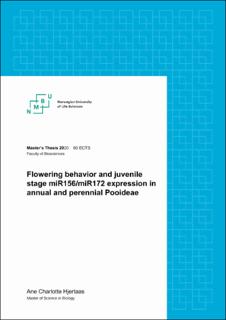| dc.contributor.advisor | Fjellheim, Siri | |
| dc.contributor.advisor | Paliocha, Martin | |
| dc.contributor.author | Hjertaas, Ane Charlotte | |
| dc.date.accessioned | 2021-02-03T14:55:06Z | |
| dc.date.available | 2021-02-03T14:55:06Z | |
| dc.date.issued | 2020 | |
| dc.identifier.uri | https://hdl.handle.net/11250/2726037 | |
| dc.description.abstract | Most plant seedlings undergo a juvenile stage of development, during which they are unresponsive to environmental signals that promote floral competence. The length of this phase is often extended in perennial versus annual species, whereby changes in the temporal expression patterns of two microRNAs, miR156 and miR172, and their targets, regulates the juvenile to adult transition and flowering in Brassicaceae species. Here I show that annual grasses of the subfamily Pooideae have shorter juvenile phases than their perennial counterparts, and that miR156/miR172 levels can explain developmental transitions in several Pooideae species as well as differences in flowering behaviour between growth habits. I also identified a novel profile for Brachypodium sylvaticum miR156 reduction in response to vernalization, perhaps involved in a yet undescribed floral pathway. | en_US |
| dc.language.iso | eng | en_US |
| dc.publisher | Norwegian University of Life Sciences, Ås | en_US |
| dc.rights | Attribution-NonCommercial-NoDerivatives 4.0 Internasjonal | * |
| dc.rights.uri | http://creativecommons.org/licenses/by-nc-nd/4.0/deed.no | * |
| dc.title | Flowering behaviour and juvenile stage miR156/miR172 expression in annual and perennial Pooideae | en_US |
| dc.type | Master thesis | en_US |
| dc.description.localcode | B-BIOL | en_US |

